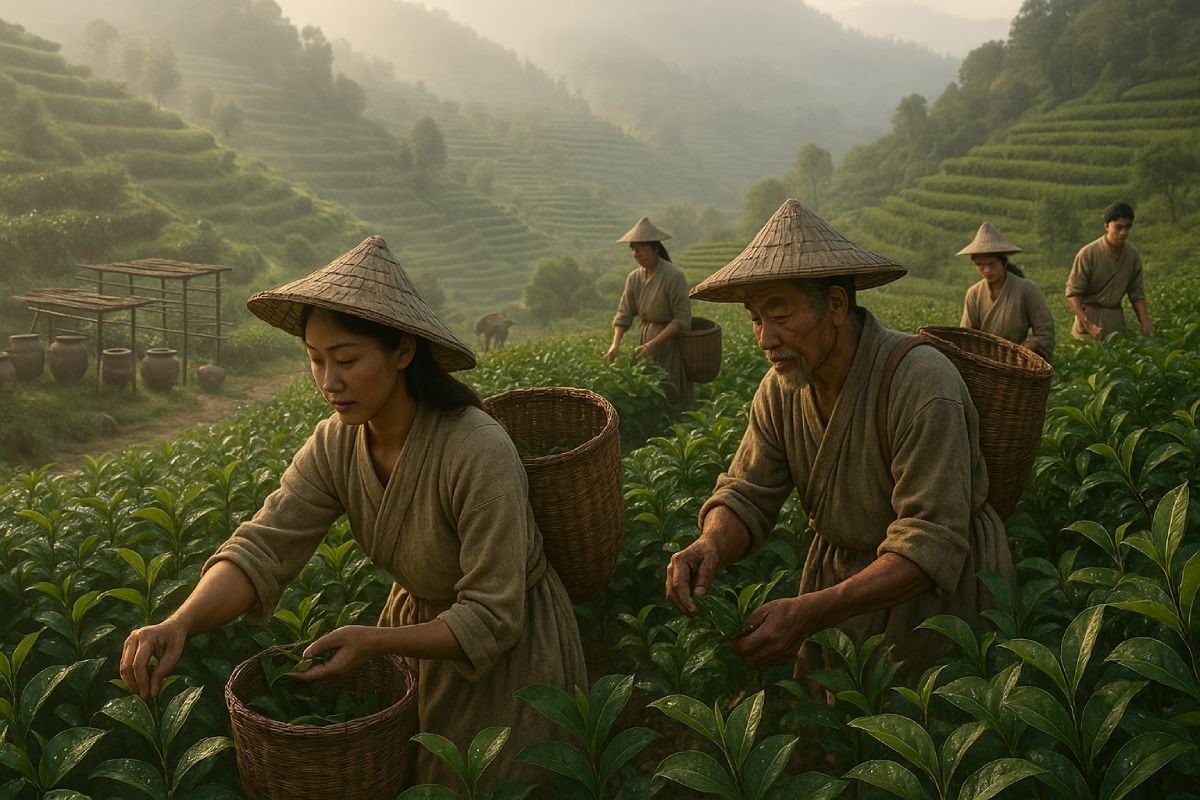The history of tea is a fascinating journey spanning millennia—shaping cultures, inspiring ceremonies, and driving global trade. Understanding tea’s past deepens our appreciation for the timeless beverage we enjoy today. Legend places tea’s discovery in ancient China when Emperor Shen Nong sampled a fragrant brew after leaves fell into boiling water. Early Chinese texts refer to tea as “ch’a”, a character that symbolically connects people and nature. By the 4th–8th centuries, tea was no longer just medicinal—it became a daily pleasure. Plantations expanded, merchants prospered, and refined tea wares signaled wealth and status. Until the mid-17th century, China primarily produced green tea. As foreign trade expanded, producers adopted fermentation/oxidation techniques to create black tea, which traveled better and preserved flavor for long journeys—transforming tea into a durable global commodity. Tea remains central to Chinese culture—expressed through regional specialties, ceremonies, education, and tourism. Competitive tea arts programs and large museums and theme complexes celebrate centuries of craftsmanship and hospitality. Explore Chinese teas: Shop Green Tea Shop Oolong Shop Pu-erh By the 9th century, China introduced tea to Tibet. Harsh terrain made local cultivation difficult, so tea arrived via long, treacherous yak caravans. Tea bricks became currency and a daily staple. Traditional Tibetan tea is simmered, strained, and churned with yak butter and salt, helping replace nutrients lost at high altitude. Hospitality etiquette holds that a guest’s cup should never be empty. In the early 9th century, Buddhist monks brought tea seeds and knowledge from China to Japan, where tea supported meditation. By the 15th century, the Japanese tea ceremony (Chanoyu)—influenced by Zen ideals of harmony, purity, respect, and tranquility—emerged as a disciplined art. The ceremony centers on whisked matcha (powdered green tea). Later, innovations in steaming leaves popularized greener, aromatic steeped teas. Tea reached Russia in the 17th century as a diplomatic gift, then spread via camel caravans that traversed thousands of miles—later replaced by the Trans-Siberian Railway in 1903. Tea became woven into social life, often served from ornate samovars. Portugal and the Dutch introduced tea to Europe in the early 1600s. British enthusiasm soared after Catherine of Braganza popularized tea at court in 1662. As a costly import, tea signified status, inspiring elaborate etiquette and tea services. The East India Company dominated tea trade for centuries, shaping geopolitics, ports, and colonial economies. Competition opened in 1833, but the company’s legacy—spanning Hong Kong, Singapore, India, and more—cemented tea’s role in a global marketplace. Britain’s demand for tea spurred cultivation in India, where indigenous Assam tea plants and favorable climates enabled vast plantations. Knowledge transfer—including closely guarded processing methods—helped establish famous regions like Assam and Darjeeling. Shop Indian teas: Assam Darjeeling Chai Colonial America embraced Europe’s tea customs, but taxation and protest culminated in the Boston Tea Party, nudging preferences toward coffee. The 20th century saw U.S. innovations: iced tea (popularized in 1904) and the tea bag (commercialized after a 1908 packaging experiment). All true tea comes from the Camellia sinensis plant. Differences arise from varietal, terroir, and processing steps like withering, rolling, oxidation, and drying: *General guidelines—adjust to taste and specific tea. Shop Green Tea Shop Black Tea Shop Oolong Shop White Tea Shop Pu-erh Shop Teaware Tea is cultivated across Asia and beyond, with major producers including China, India, Japan, Sri Lanka, and Kenya. Climate, soil, altitude, and craft shape each region’s character. Tea originated in China, with legend dating to around the 3rd millennium BCE. From there, it spread across Asia and eventually the world. Early Chinese tea was largely green, made from fresh or lightly processed leaves. Over centuries, techniques evolved to create oolong and black tea styles. Pu-erh from Yunnan is among the oldest enduring styles, valued for aging and depth of flavor. Green, black, white, oolong, and pu-erh (all from Camellia sinensis)—each defined by oxidation and processing. Typical steps include plucking, withering, rolling/shaping, oxidation (for oolong/black), and drying. Small changes at each step create distinct styles. Tea provides antioxidants and a gentle lift from caffeine and L-theanine. Many drinkers enjoy it as part of a balanced lifestyle. Use fresh water, appropriate temperature, and timing: green ~180°F (82°C), oolong ~190°F (88°C), black ~210°F (99°C). Adjust to taste and tea. In Japan and China, tea ceremonies honor mindfulness, hospitality, and refined technique—celebrating harmony, respect, and tranquility.
Quick Timeline of Tea
Era
Milestone
Why It Matters
c. 2700 BCE (legend)
Emperor Shen Nong (also written Shen Nung) discovers tea when leaves drift into boiling water.
Begins tea’s origin story in China.
4th–8th centuries
Tea moves from medicine to daily refreshment; plantations spread; tea wares signal status.
Tea culture scales across China.
9th–15th centuries
Tea arrives in Tibet & Japan; rituals and monastic use take hold.
Seeds of ceremonial traditions.
17th century
Black tea processing develops for long-distance trade.
Enables global export.
17th–18th centuries
Europe adopts tea; Britain popularizes afternoon tea.
Tea becomes a social institution.
18th–19th centuries
East India Company & colonial expansion; Indian plantations grow.
Tea reshapes economies and geopolitics.
1900s
Iced tea (1904) and tea bags (1908) mainstream in the U.S.
Convenience and new formats.
Ancient China: The Birthplace of Tea
The Invention of Black Tea
Tea in Modern-Day China
Tibet’s Tea History: Butter Tea & Caravan Trade
Japan’s Tea History: Zen, Matcha & Ceremony
Russia’s Tea History: From Camels to Railways
Europe’s Tea History & Britain’s Rituals
Afternoon Tea vs High Tea
The Role of Tea in Globalization
India’s Tea History: Assam, Darjeeling & Beyond
North America’s Tea Story: Revolution to Innovation
Types of Tea & How Tea Is Processed
Type
Typical Processing
Flavor Snapshot
Brew Temp & Time*
Green
Minimal oxidation; pan-fired or steamed
Fresh, grassy to umami
~175–185°F (80–85°C), 1–3 min
White
Delicate withering & drying
Soft, honeyed, floral
~175–185°F (80–85°C), 2–4 min
Oolong
Partial oxidation
Orchid to roasted, complex
~185–200°F (85–93°C), 2–4 min
Black
Full oxidation
Malty, brisk, robust
~200–212°F (93–100°C), 3–5 min
Pu-erh
Fermented/aged
Earthy, smooth, deep
~200–212°F (93–100°C), multiple short steeps
Frequently Asked Questions on the History of Tea
Where is tea grown?
Where did tea originate?
What kind of tea did the ancient Chinese drink?
What is the oldest tea in China?
What are the different types of tea?
How is tea processed?
What are the health benefits of tea?
How do you brew tea?
What is the tea ceremony?
